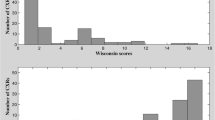Abstract
Background
Several imaging-based scoring systems have been used as outcome measures in assessing the severity of cystic fibrosis (CF) lung disease. It has been shown that chest radiography performs equally to computed tomography (CT). There is the opinion that of the two most commonly used chest radiograph (CXR) systems, the Brasfield system is less sensitive and reliable than the Wisconsin system.
Objective
This report assesses the reproducibility and reliability of the two systems.
Materials and methods
Thirty patients with CXRs during a 5-year period were randomly selected. One hundred eighty-two studies had data for all CXRs and pulmonary function tests (PFTs), Forced Expiratory Volume in One Second (FEV-1) and Forced Vital Capacity (FVC). PFT values closest to the date of each CXR were recorded. Four radiologists scored each image twice by both the Brasfield and Wisconsin systems. Intra- and inter-rater reliability, correlation with PFTs and direct correlation of the two systems were calculated.
Results
Intra-rater agreement: r = 0.86–0.99 Brasfield, r = 0.78–0.96 Wisconsin. Inter-rater agreement: 0.76–0.90 Brasfield, r = 0.74–0.97 Wisconsin. Brasfield vs. FEV-1: r = 0.55, vs. FVC r = 0.61. Wisconsin vs. FEV-1: r = 0.57, vs. FVC r = 0.66. Correlation of the two systems: r = 0.86 (all P < 0.001).
Conclusion
The Brasfield and Wisconsin systems performed very similarly providing equally reproducible, robust and reliable measures.

Similar content being viewed by others
References
Cleveland RH, Neish AS, Zurakowski D et al (1998) Cystic fibrosis: a system for assessing and predicting progression. AJR Am J Roentgenol 170:1067–1072
Cleveland RH, Neish AS, Zurakowski D et al (1998) Cystic fibrosis: predictors of accelerated decline and distribution of disease in 230 patients. AJR Am J Roentgenol 171:1311–1315
Brasfield D, Hicks G, Soong S et al (1980) Evaluation of scoring system of the chest radiograph in cystic fibrosis: a collaborative study. AJR Am J Roentgenol 134:1195–1198
Wong EB, Regnis J, Shnier RC et al (1993) The relationship between tests of lung function and three chest radiological scoring systems in patients with cystic fibrosis. Australas Radiol 37:265–269
Sawyer SM, Carlin JB, DeCampo M et al (1994) Critical evaluation of three chest radiograph scores in cystic fibrosis. Thorax 49:863–866
Weatherly MR, Palmer CG, Peters ME et al (1993) Wisconsin cystic fibrosis chest radiograph scoring system. Pediatrics 91:488–495
Matthew DJ, Warner JO, Chrispin AR et al (1997) The relationship between chest radiographic scores and respiratory function tests in children with cystic fibrosis. Pediatr Radiol 5:198–200
Bhalla M, Turcios N, Aponte V et al (1991) Cystic fibrosis: scoring system with thin-section CT. Radiology 179:783–788
Nathanson I, Conboy K, Murphy S et al (1991) Ultrafast computerized tomography of the chest in cystic fibrosis: a new scoring system. Pediatr Pulmonol 11:81–86
Brody AS, Klein JS, Molina PL et al (2004) High-resolution computed tomography in young patients with cystic fibrosis: distribution of abnormalities and correlation with pulmonary function tests. J Pediatr 145:32–38
Brody AS, Kosorok MR, Li Z et al (2006) Reproducibility of a scoring system for computed tomography scanning in cystic fibrosis. J Thorac Imaging 21:14–21
Sanders DB, Li Z, Brody AS et al (2011) Chest computed tomography scores of severity are associated with future lung disease progression in children with cystic fibrosis. Am J Respir Crit Care Med 184:816–821
Zeger SL, Liang KY (1986) Longitudinal data analysis for discrete and continuous outcomes. Biometrics 42:121–130
Cleveland RH, Zurakowski D, Slattery DM et al (2007) Chest radiographs for outcome assessment in cystic fibrosis. Proc Am Thorac Soc 4:302–305
Slattery DM, Zurakowski D, Colin AA et al (2004) CF: an X-ray database to assess effect of aerosolized tobramycin. Pediatr Pulmonol 38:23–30
Cleveland RH, Zurakowski D, Slattery D et al (2009) Cystic fibrosis genotype and assessing rates of decline in pulmonary status. Radiology 253:813–821
Lin LI (1989) A concordance correlation coefficient to evaluate reproducibility. Biometrics 45:255–268
King TS, Chinchilli VM, Carrasco JL (2007) A repeated measures concordance correlation coefficient. Stat Med 26:3095–3113
Cohen J (1988) Statistical power analysis for the behavioral sciences, 2nd edn. Routledge, New York, New York
Conflict of interest
None
Author information
Authors and Affiliations
Corresponding author
Rights and permissions
About this article
Cite this article
Cleveland, R.H., Stamoulis, C., Sawicki, G. et al. Brasfield and Wisconsin scoring systems have equal value as outcome assessment tools of cystic fibrosis lung disease. Pediatr Radiol 44, 529–534 (2014). https://doi.org/10.1007/s00247-013-2848-1
Received:
Revised:
Accepted:
Published:
Issue Date:
DOI: https://doi.org/10.1007/s00247-013-2848-1




